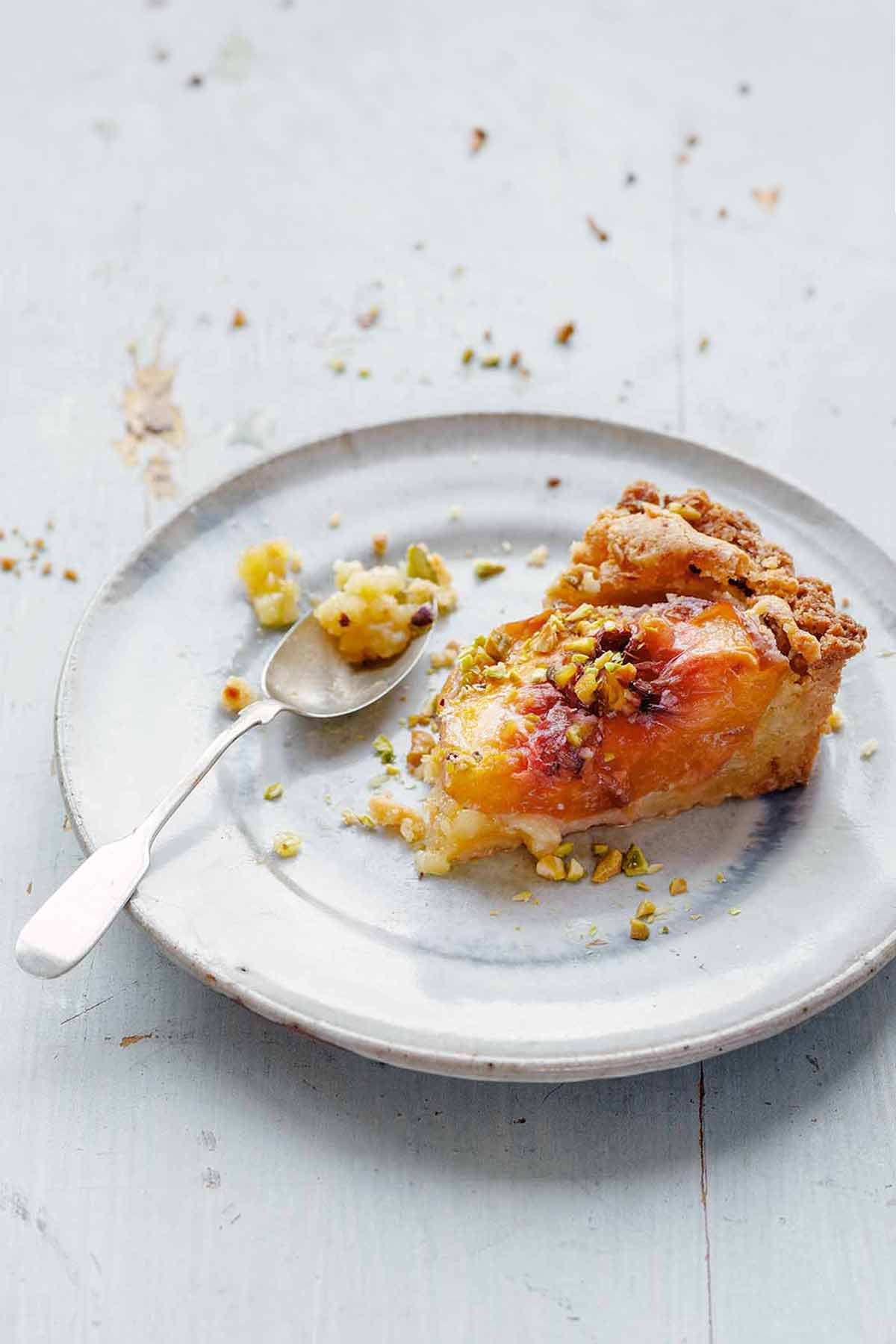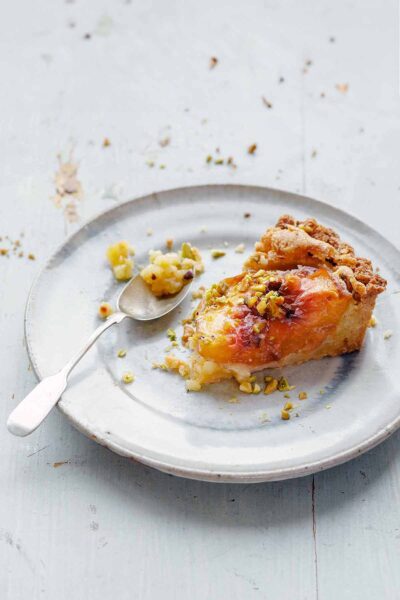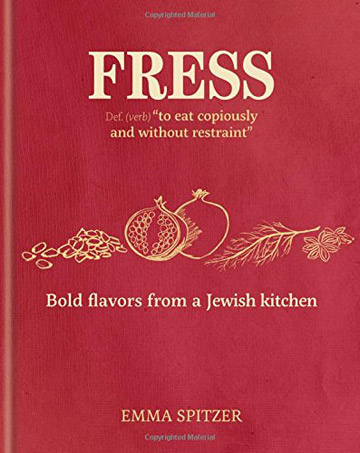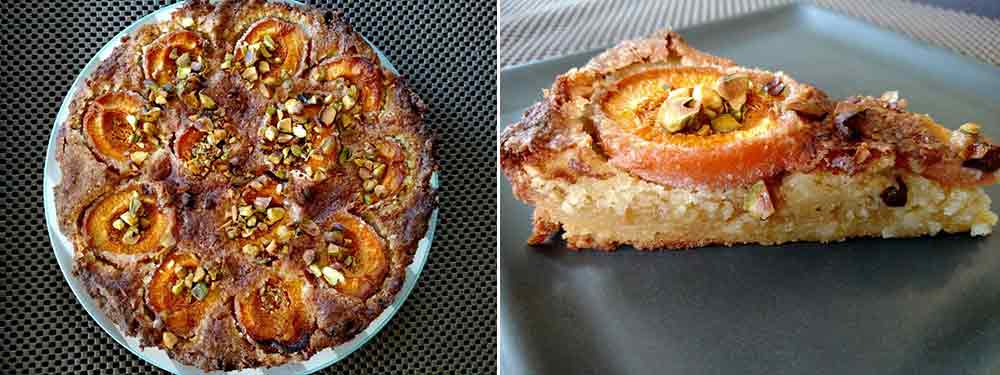
This is the show-stopping summer dessert to pull out when you really want to impress guests. In classic Italian tradition, a rich, creamy, almost silken apricot and almond filling is juxtaposed with flaky pastry. It takes a little time. But the oohs and aahs that each forkful bring are worth every moment of effort.–Angie Zoobkoff
Apricot Frangipane Tart FAQs
Orange blossom water brings the subtle essence of orange to recipes. Sorta as if someone had waved an orange over a vial of water and chanted some incantations. It’s made from orange blossoms rather than orange zest so it lends your recipes a lighter, arguably lovelier, lilt than you may expect.
Frangipane is a sweet custard made from almonds, butter, sugar, and eggs that is often used in tarts and pies. It can be made with other nuts too, and occasionally, liquor is added to the mixture. It’s not the same as marzipan, which is a thick paste.

Apricot Tart with Frangipane
Equipment
- 9-inch (23-cm) fluted tart pan with a removable bottom
Ingredients
For the pastry
- 1 1/2 cups all-purpose flour, plus extra for dusting
- 1 teaspoon mahleb (mahlepi) powder (optional)
- Pinch table salt
- 1 1/2 sticks (6 oz) cold unsalted butter, cut into pieces
- 1/4 cup confectioners’ sugar
- 2 large egg yolks
For the filling
- 1 1/2 sticks (6 oz) unsalted butter, softened, plus extra for the pan
- 1 cup superfine sugar
- 1 cup whole blanched almonds
- 2 large eggs
- 1 tablespoon orange blossom water
- 6 ripe apricots, halved and pitted
- 2 tablespoons chopped unsalted pistachio nuts
Instructions
Make the pastry
- In a food processor, add the flour, mahleb powder, if using, salt, and butter in a food processor and pulse to combine. Toss in the confectioners’ sugar and egg yolks and pulse until the mixture starts to come together into a dough.
- Turn the dough out onto a lightly floured work surface and then gather it into a ball and gently flatten it to a disk, wrap it in plastic wrap, and refrigerate for an hour.
- Butter a 9-inch (23-cm) fluted tart pan with a removable bottom. Grab a hand grater and use the coarse side to grate the pastry dough into the tart pan. Gently press the dough into the pan and up the sides, making sure that the bottom and sides are evenly covered and there are no gaps. [Editor’s Note: We know. This seems like a ridiculously unconventional way to make a crust. But trust us. It works. Trust us. Resist the urge to simply pat the dough into place.] Refrigerate for 30 minutes.
- Meanwhile, preheat the oven to 400°F (200°C).
- Line the pastry with a sheet of parchment paper and fill the crust with uncooked beans or rice to weight it and hold it in place. Then bake the pastry for 15 minutes.
- Slowly and carefully remove the paper along with the beans or rice. Some of the pastry may separate; if this happens, gently press it back together with the back of a spoon. Bake the uncovered pastry until lightly golden, 7 to 15 minutes more. If the crust begins to brown at the edges, loosely cover the edges with a thin strip of aluminum foil.
- Let the crust cool completely while you make the filling.
Make the filling
- Reduce the oven temperature to 340°F (170°C).
- In an electric mixer fitted with the paddle attachment, beat the softened butter and sugar together until pale and light.
- In the food processor, pulse the almonds to a to a coarse rubble; you don’t want powder, so be careful not to overwork them. Beat the almonds into the butter and sugar, then beat in the eggs, 1 at a time, and finally add the orange blossom water, gently mixing just until everything is combined.
Assemble the apricot tart
- Spoon the filling into the crust and top with the apricot halves, cut-side up. Place the tart pan on a rimmed baking sheet lined with foil and bake for 50 minutes. Remove from the oven and scatter with the chopped pistachios. Bake until the tart is a deep golden, 15 to 20 minutes more.
- Let the tart cool completely in the pan. Then when you’re ready to show it off, remove the side of the tart pan, slice, and prepare to receive accolades.

Explore More with AI
Nutrition
Nutrition information is automatically calculated, so should only be used as an approximation.
Recipe Testers’ Reviews
You will be so proud to present this beautiful and truly impressive apricot tart with frangipane to your guests. Although it requires a bit of time, it’s a relaxing recipe with much of the required time applying to chilling, baking, and cooling. This showy dessert was fun to make and boasts of complex and delicious flavor components and textures.
Oh, and about that light, crunchy, flavorful crust! It was awesome! I was a bit concerned about following the directions to simply pile the grated dough into the tart pan. I was very tempted to pat it down molding it into all the nooks and crannies of the fluted pan. I am so glad I resisted the urge! The crust beautifully (and seemingly magically) filled and formed the shape of the pan as it blind-baked, and allowed for easy removal from the pan once filled, cooked, and cooled.
After not-so patiently waiting for this beautiful creation to cool, the first tasting was admittedly a little disappointing. We all thought initially that in contrast to each other, the filling seemed too sweet and the apricots seemed too tart. I expected the flavors to meld together more.
However, the next day, that is exactly what happened! The combination of the filling and the apricots, along with the flavor components of orange blossom, almond and pistachio, resulted in an absolutely perfect and satisfying harmony. Yes, feel free to make ahead as this is better—MUCH better on the second day!
My ripe apricots were large and it didn’t seem possible or logical to drop the halved apricots on top of the frangipane, they were just too big, so instead I sliced each one into 8 wedges and placed them, peel edge down, close together in what I can best call a concentric sunburst pattern.
This apricot tart with frangipane is show-stopper indeed, and a nail-bite. Making this frangipane was a wild ride! I’m so glad I made it though, as we can’t wait to enjoy this divine tart again.

The finished frangipane was gorgeous and absolutely delectable. Every element had the right texture and flavor—golden brown (even the entire bottom) buttery crust, not-too-sweet almond filling with beautiful floral notes of orange blossom water, and tender apricots with refreshing tartness.
How was making it a wild ride? Well first, I felt nervous about just grating the dough and not pressing it into the pan before baking the crust. But when I lifted the pie weights I was relieved to see that the shredded dough had puffed up and filled in any gaps that may have been there (phew).
The excitement wasn’t over then. I checked the frangipane after it baked for 30 minutes, and realized some of the filling had begun to overflow (thank goodness for the foil-lined baking sheet underneath it). Maintaining Julia Child’s just-keep-going attitude, I closed the oven door, took a deep breath, and proceeded with the rest of the steps.
By the time the frangipane finished baking with pistachios on top, it couldn’t have looked more disastrous with a greasy bubbling black mess all over outside of the tart pan. But seeing that the tart itself wasn’t burned (a big phew), I knew there was still hope.
While the gooey mess was still hot, with a paper towel I carefully pushed the overflowed filling down the side and away from the pan (I felt like an archaeologist brushing dirt off of an ancient gem). Revealed was a beautiful frangipane, perfectly presentable at any special occasion.
The tart took 2 hours to completely cool, but the texture was still a bit delicate for cutting. After 3 more hours it sliced significantly cleaner, as the crust, the filling, and the apricots had settled together more tightly.
But the real pleasant surprise came the following day. I had refrigerated the leftover portion (unsliced), and discovered that this frangipane could be made a day ahead without losing its superb quality—the filling was still moist and fragrant, the crust was not soggy even the slightest, and the apricots still tasted fresh.
In the end, this frangipane triumphed and was adored by all—a little anxiety was a small price to pay!
This apricot tart with frangipane is rich in taste so a small slice is definitely enough. The texture of the cake was very pleasant. It had a lovely taste—almond, orange, apricot, and pistachio were all evident in the taste.
The apricots were not visible in the finished cake as the frangipane had baked up over them.
The pastry dough was very sticky after adding the butter and I wondered how I would be able to work with the dough. Then I saw that the dough was to be grated onto the baking pan. This is a technique that I have not used before and I wondered if I should be pressing the grated dough down into the case and if it should be pressed into the sides of the flan pan.
Next time I might press the pastry into the pan and up the sides. I might also try to roll the pastry out, but I suspect it is too buttery to do that easily.
I would recommend this cake—it reminded me of Moroccan flavors.
One bite, and taste testers were gone: “Oh my!” “THIS is incredible.” “The texture is fantastic.” “What a flavor—can I have more, now?”
Indeed, the flavor is heavenly and the texture—light and merengue-ish with bits of course almonds and also jammy sweet fruit—is another level of divine. Everyone loved this tart.
The orange blossom water is very subtle in the finished tart, but adds a lovely essence.
The crust method is fussy compared to our standard crust—we make a lot of tarts and pies in the summer—and we will make the filling again, yes, but use a simpler (and equally delicious) tart crust method. For baking, a pan under the tart is essential – the filling spilled over the edges of the tart, which made it tricky to separate from the removable ring. Strangely, the butter (from the crust?) separated and created a pool of oil in the pan. I’ve never seen that, so, again: you must place this tart on a pan before putting in the oven
After the initial 50 minutes baking, the tart was very well browned and we sprinkled with pistachios and baked another 10, rather than 20, minutes. We could not find apricots, so we used excellent perfect yellow peaches, which were fabulous. However, apricots probably would be even more spectacular (next spring we will try again).
We did not use mahleb and used peaches. We made this in a kitchen with no food processor, so we ground the almonds roughly in a coffee grinder—the uneven texture of the nuts added to the wonderful texture.
Like the word “frangipane,” an elegant word to describe a simple almond filling, this tart sounds sophisticated but turns out to be perfectly homey and rustic.
For the cook, this is an assembly of an easy cookie pastry crust, then a soft buttery-almond filling, topped with seasonal fruit. The sophistication is all on the part of the flourishes (all optional, if you ask me), and could either be dialed up to fancy-fancy, or adapted to be as rustic as you like. The fluted tart pan creates a fancy shape but could swap for a cake pan or pie plate; exotic spicing in the crust wasn’t missed as mahleb powder eluded me; a haunting touch of orange flower water in the filling was forgotten until baking was complete.
In the end, this tart baked up fragrant, with a plush almond filling, crisp crumbly crust, and soft jewels of jammy fruit. I do recommend using fruit that is flavorful; without apricots around, I topped half with tiny, very ripe prune plums (a win), but the other half, with carefully arranged too-firm peach slices was a loss—nsulated by the cushion of filling, the oven’s heat didn’t soften the underripe fruit. Other fruits I’d try include pears or cranberries…maybe for a holiday variation.
I used granulated sugar for the superfine. I also totally cheated and used almond meal for almonds, weight for weight. (I barely had enough raw almonds and was going to top it up with meal anyway. This sub worked GREAT and was a more even texture then I’d have achieved grinding myself.)
No apricots in the store so I topped one side with 4 halved tiny prune plums, the other with 8 slices of a sadly underripe white peach. I used a 9-inch springform cake pan as my tart pan is 11 inches. I pulled the tart after 50 minutes, it was puffed and the filling was dry in the center but still soft. I let it sit for a full day at room temp before bringing it to dinner…the crust stayed nicely crisp. The next day in the fridge made the crust a bit soggy and it wasn’t as good.
This apricot frangipane tart was a joy to the senses. The finished dessert was beautiful with the golden brown top and glistening apricot halves. The fragrance of apricot mixed with orange blossom and almond was a delight to the nose. The frangipane filling crisped on top where it pushed through the apricot halves. With the addition of a scattering of pistachios, there was good textural contrast between the topping, crust, fruit, and filling in each bite.
The crisp top yielded to a light, moist center that almost melted into the bottom crust. The bottom crust remained light and not dense with the technique of grating the dough into the pan and only patting it down enough to ensure that the entire bottom and sides were covered.
The baking of this tart was not without some technical difficulties—all of which can be avoided in the future. Luckily I kept an eye on the crust while it was in the oven. The edges began to brown too quickly when the pie weights and parchment were removed. I needed to add an aluminum foil ring to ensure that the edged did not burn. By not compacting the dough into the pan, the baked crust could not accommodate all of the batter and fruit. My nose alerted me to the fact that the batter was bubbling over the side of the tart pan and burning on the bottom of my oven. I quickly added a sheet of aluminum foil to the rack below. In order to avoid this in the future, I would reduce the amount of batter that I added to the shell by 1/2 to 3/4 of a cup.
While everyone enjoyed the floral notes and flavor that the orange blossom water provided, I found it to be borderline too strong. The next time that I make this, I will only use 1/2 to 3/4 of a tablespoon.














Hi Everyone
Well I made the tart with peaches, I had to finish baking it with foil on top because I wanted the center to finish baking without burning. I didn’t have apricot jam to brush on so I used boiled cider to give her some glam. Thank you for this recipe, it’s a keeper!!
Wow, Giselle! That looks absolutely fabulous.
Aaww thank you!!
You’re welcome, Giselle!
Hi
I have peaches as well so I’ll give it a go. My question is I make macarons all the time, so can I use almond flour in lieu of the blanched almonds? I’m so looking forward to making this beautiful tart.
I think that should work ok, Giselle. Please let us know how it turns out!
Oh I’ll definitely take pictures, keeping my fingers crossed ??
Great! Can’t wait to see them, Giselle.
Me too lol!!